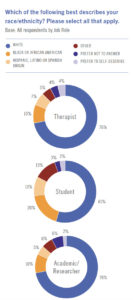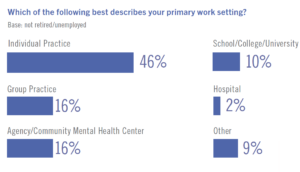In the first half of 2022, AAMFT conducted an industry workforce study to examine the shifts related to COVID-19, their short- and longer-term impacts, and what challenges and opportunities are facing the field.
Introduction
The field of marriage and family therapy has evolved greatly over its development. From the early days gathering around a table to share ideas and consult about cases to an online gathering of over 7,000 MFTs from nearly every continent, the profession has grown incredibly through the years. And while these past stages have been instrumental in shaping where our profession is today, they did not occur overnight. They were the result of decades of thought evolution and effort on the part of many dedicated systemic thinkers. For example, the process of achieving professional licensure throughout the United States extended from 1963 through 2009 and involved hundreds if not thousands of engaged advocates.
Fast forward to 2020 and, like every facet of our global society, the marriage and family therapy profession was profoundly impacted by the unprecedented COVID-19 pandemic. While other environmental factors like technology, access to education, and the expansion of licensure had quickened shifts in our field in the past, never before had something impacted nearly every marriage and family therapist (MFT) across the globe overnight.
Throughout the pandemic, and in the societal shifts that resulted since, MFTs have been instrumental in helping to navigate new paths. The need and demand for mental health services has never been greater. Those already in the field are experiencing their highest caseloads and facing challenges related to burnout, shifting business models, and reimbursement rates. And while data indicate the field has grown and will continue to do so with COAMFTE-accredited program student enrollment up 31% over the last five years and growing annually, it may be a very different professional landscape than in past years.
To better understand how these changes have permanently impacted our industry, and how the emerging trends and challenges may continue to do so, AAMFT partnered with McKinley Advisors, an association research and consultancy group, to conduct an industry workforce study. The results of this study are shared throughout this report as well as insights provided by the thousands of MFTs who contributed to the results.
“Throughout the pandemic, and in the societal shifts that have resulted since, MFTs have been instrumental in helping to navigate new paths.”
Research Methodology and Response
The research was conducted in two phases: (1) a set of qualitative interviews with key AAMFT leaders and stakeholders designed to help inform the direction of the larger research and (2) a quantitative survey of both AAMFT members and non-member MFTs as well as those in training.
Phase one involved input from 21 MFTs spanning from early career to late career experience.
Phase two, the electronic survey, was distributed via email to 25,879 contacts provided by AAMFT. McKinley initially launched the survey, and AAMFT followed with subsequent reminder emails. The survey was fielded over 15 days from June 7, 2022 to June 22, 2022. In total, 3,108 respondents completed or partially completed the survey questionnaire for a total response rate of 12%. This is in line with other surveys McKinley Advisors has conducted as well as response rates in the field of market research. For example, Pew Research, which conducts major opinion polls regularly, has historically received response rates between 5% and 15%. In recent years, typical response rates have averaged 6%.
Part 1: Shifting Demographics in the Profession
In 2012, when AAMFT last conducted a research survey examining demographics within the profession, there were several trends that were noted for their potential impact on the profession moving forward. These areas are highlighted throughout the section including new areas for future focus.
Diversity
In 2012, diversity within the field was beginning to show signs of growth, particularly within racial and ethnic demographics. While total respondents at the time only indicated 17% population that identified as a person of color, student respondents showed significantly more diversity with nearly 27% identifying as a person of color.
In 2022, the racial and ethnic diversity in the field has continued to grow with over 25% of respondents indicating they identified as a person of color. Growth was particularly notable among those in the field identifying as Black/African American (up from 4.3% of respondents in 2012 to over 11% of respondents in 2022) and Hispanic, Latino or Spanish origin (up from 3.77% in 2012 to 7% in 2022). Within student responses, this growth in diversity was even more prominent. Racial/ethnic diversity among researchers and academics was similar to overall response trends.
Similar to the 2012 survey, the MFT field continues to be predominantly composed of those who identify as women (77%), with 19% responding they identify as male, and 2% as gender nonconforming/binary.
 Age and tenure of respondents was evenly distributed among all categories. Over one-third (34%) reported working in the field for 11-20 years, and a fifth (20%) for over 20 years. A quarter (25%) worked in the field for less than 6 years, and a fifth for 6-10 years (20%). About a fifth reported being between the ages of 31-40 (23%), 41-50 (22%), or 51-60 (20%).
Age and tenure of respondents was evenly distributed among all categories. Over one-third (34%) reported working in the field for 11-20 years, and a fifth (20%) for over 20 years. A quarter (25%) worked in the field for less than 6 years, and a fifth for 6-10 years (20%). About a fifth reported being between the ages of 31-40 (23%), 41-50 (22%), or 51-60 (20%).
These data are of note because in 2012, over 35% of AAMFT members were 65 years of age or older and the average age of an AAMFT member was 50 years old. The threat of a retirement bubble burst was one of the key emergent challenges. Today, the percentage of members over 65 years of age has lowered to 20% and the average age is 45.7 years. The average student member age in 2022 is 34.5 years with over 40% under the age of 30.
 Education
Education
A concern that emerged following the 2012 study was student respondents indicating they planned on pursuing a doctoral degree (<12%), was significantly less than the 33% at the clinical level that indicated at that time that they held a doctoral degree. In 2022, this data point continued to cause concern with only 20% of respondents indicating they held a doctoral degree.
In some ways, this shift is not surprising since financing the cost of education was ranked as a top frustration in becoming an MFT, cited as the number one challenge by over 53% of respondents under 40. However, it does amplify the concern initially identified in 2012; if less of the industry is pursuing doctoral degrees, how does this impact the research and education in marriage and family therapy? Are MFTs leaving the profession open to be defined and grown by other disciplines who may lack their unique training and expertise?
While AAMFT can do little regarding the cost of education, it is taking steps to boost the profession’s ability to conduct research. For example, in 2020 AAMFT launched the Intervention Research in Systemic Family Therapy topical interest network. Since its inception, the Network has held two research conferences.
MFT Identity
In 2012, just over 60% of respondents indicated they were licensed as an MFT. In 2022, this percentage has increased to 77% with another 20% indicating they intend to become licensed as an MFT.
While in 2012, the industry still reflected a substantial amount of dual licensure – particularly within our longer tenured MFTs – today more respondents indicate they exclusively hold an MFT license (72%). Counseling was the second most held license (12%), followed by social work (2.8%), psychology (2.2%), and nursing (1%).
In today’s environment, there are more COAMFTE-accredited MFT training programs than ever and MFT is a professional license available in all U.S. states. Further, MFT is gaining recognition both as a service and profession requiring regulation throughout the world.
This shift towards a more distinct MFT identity is certainly a positive one for the profession. However, it does create pressures on industry organizations like AAMFT to facilitate unity and strategic, impactful voice while representing the smallest of the major mental health professions. More than ever, it is vital that resources and efforts are available to advocate for the protection and expansion of the MFT profession.
Today, the AAMFT Professional membership is about 22% of estimated total licensees. While AAMFT partners with other MFT and mental health organizations, the bulk of the advocacy for the expansion and protection of the profession falls to AAMFT as the only national association representing MFTs. This means that on-going support for these vital efforts is dependent on less than a quarter of the LMFTs in the country.
“MFT is gaining recognition both as a service and profession requiring regulation throughout the world”
Workplace Setting
Respondents indicated that the vast majority are still working in individual (46%) and group private practice (16%), similar to 2012. This correlates with other aspects of the workforce study where nearly half of those licensed as MFTs, or intending to be licensed, identified getting fair private insurance reimbursement (49%) and the growing need to continue services with clients across state lines (48%) as the top impending challenges for the profession.
As outlined more extensively in the trends and challenges section of this report, a vast majority of respondents indicated that they intend to continue both in-person and telehealth services moving forward. While this does create more flexibility in service delivery, and may improve access to care, it does create greater business expenses for the clinician. It also increases the need for strong ethics and best practice training and guidance in emergent service delivery practices.

A key takeaway from the study was a desire for increased advocacy efforts related to licensure portability, parity with other mental health disciplines, and reimbursement. AAMFT’s Practice Protection Fund (PPF) is designed to help support vital growth efforts like these, as well as work against threats and challenges to the profession. Unfortunately, it is supported by less than a quarter of licensed MFTs in the U.S. Please donate to this vital work by texting PPF to 53-555, or visiting givebutter.com/PPF
>>To download the full report, visit aamft.org/workforcestudy
Other articles
AAMFT’s Next Evolution
Throughout AAMFT’s history, there have been eras of focus by the Association. Of course, in the early days, AAMFT was simply focusing on establishing itself as an association. Such things as naming, determining who could be a member, and deciding what exactly its purpose was marked the era. Nichols (1992) referred to this time period as the Elitist Period. Of course, other periods were highlighted by Nichols including the Washington Period which he identified as beginning in 1982 and included advocacy.
Tracy Todd, PhD
Treating Families of Young Children with Disruptive Behavior at School: A Systemic Approach
Several years ago, before starting my journey as a marriage and family therapist (MFT), I found myself inside a preschool meeting room, seated across from a row of tense-faced women—a teacher, a psychologist, and the school director. They had a problem on their hands—an oddly precocious five-year-old boy who wouldn’t always cooperate, frequently talked back, and, most recently, had hit and kicked his teacher, boldly identifying her as, not only “mean,” but “stupid.”
Marisa Beck, MS
Systemic Perspectives on Perinatal Mental Health: Six Major Changes for Parents
Amy* was sitting slumped on a couch in my office for her initial appointment. She appeared a little nervous but was trying to hold it together. After pleasantries were exchanged, she stated she had her son four months ago, and since then, things had changed a lot around the house and with the family, especially with her in-laws. She explained she was feeling anxious, was short of breath, had overwhelming worries, and was irritable for the last couple of months.
Keiko Yoneyama-Sims, MS



